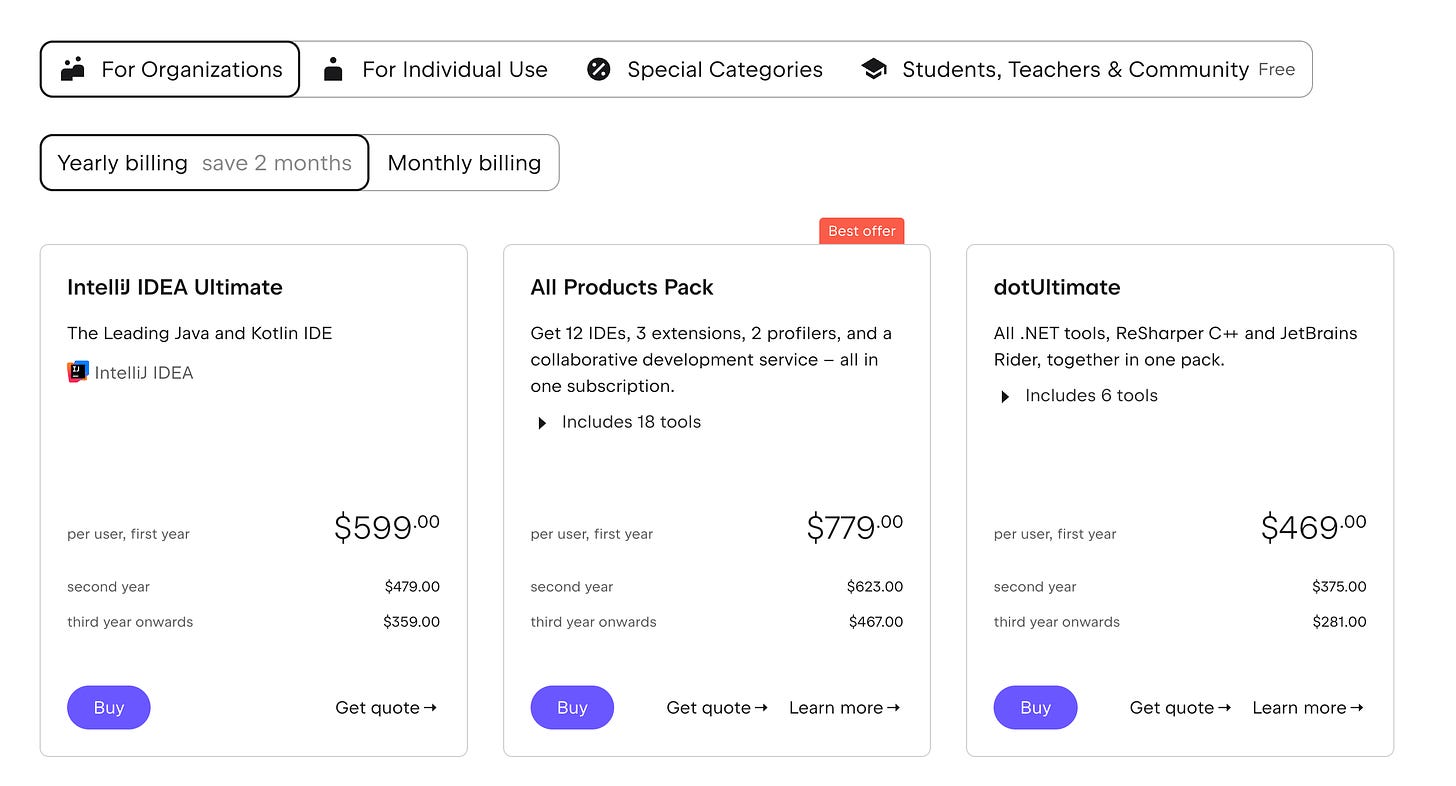When Steve Jobs famously called the computer a “bicycle for the mind,” he was capturing an essential truth: technology’s value lies in how much it amplifies human capability. Bicycles take our relatively slow legs and let us move fast and far. Computers do the same for thought - but just how far can we push that analogy? If a computer is a mental bicycle, then an advanced AI coding assistant like ChatGPT might be the first hint of a fully self-driving car for the mind. And if that’s the case, how much is that kind of capability really worth?
Of course, $200 per month for a coding assistant will feel steep to many individual developers today. Some will argue that current AI models, while impressive, are not yet delivering an experience consistently powerful enough to justify such a price tag. It’s a valid concern. For these developers, the tool may still feel more like a “nice-to-have” than a mission-critical asset.
But that’s only one side of the story. As professionals in fields like design, finance, law, and marketing increasingly adopt these AI assistants - often at similar or higher price points - willingness to pay across the broader market is clearly on the rise. And considering how quickly large language models have advanced, there’s a strong case that we’re just one or two more iterations away from AI coding assistants moving fully into the mainstream developer toolkit. Year over year, AI undeniably becomes more useful to developers, and the goalposts for what’s considered “worth it” keep shifting.
Early Days (1980s–1990s): Expensive, Niche Tooling
In the earliest eras of personal computing and the growth of the software industry, developer tools were often proprietary, expensive, and tightly bundled with hardware or operating systems. Commercial compilers, linkers, and IDEs from companies like Borland or Microsoft could cost hundreds - if not thousands - of dollars per seat. While large enterprises would foot these bills without much hesitation, it wasn’t typical for an individual engineer to reach into their own pocket for professional tooling. Access to these tools often came through one’s employer, as software was delivered on physical media and packaged in complex license agreements.
Open Source Revolution (1990s–2000s): The Era of “Free”
The emergence and mainstreaming of open source software (OSS) in the late ’90s and early 2000s had a profound effect on developer tools pricing. The era of Eclipse, GCC, Git, and eventually GitHub was one where “free as in beer” became the default baseline. Entire toolchains became available at no cost - offering not just compilers, but also version control systems, bug trackers, and build automation tools.
This democratization led many IC engineers to expect their core toolkit to be free, or at least extremely cheap. Organizations were often reluctant to pay per-seat licenses for developers, relying on OSS projects and in-house modifications to get by. The prevailing attitude was: “Why pay for something we can build or customize ourselves?”
SaaS and Subscriptions (2010s): Incremental Willingness to Pay
By the 2010s, the software world increasingly shifted toward the cloud and a subscription economy. Tools like GitHub, Atlassian’s suite (Jira, Bitbucket), and continuous integration services (CircleCI, TravisCI) introduced monthly per-user pricing - though much of it remained relatively modest. Paying $5–$10 per user per month for hosted version control or CI services started to feel acceptable. The cost was still usually footed by the employer, but these rates were low enough that even small teams, startups, or individual consultants could justify the expense.
JetBrains tools are a good example from this era. While not free, JetBrains IDEs cost on the order of a few hundred dollars per year. For many developers, that was a reasonable out-of-pocket expense to dramatically improve their development experience - especially as IDEs integrated advanced code analysis and refactoring tools. This was perhaps an early sign that certain premium experiences could convince individuals to pay.
The AI and LLM Era (Late 2010s–2020s): Pushing the Boundaries of Value
Now, with the emergence of AI-driven coding assistants, we’re witnessing another inflection point. Tools like ChatGPT Pro at $20/month (and now a $200/month higher tier) prompt a new question: how high can the price go before individual engineers balk?
To find an answer, it’s helpful to draw parallels outside of software. Designers and photographers pay Adobe’s Creative Cloud fees with relatively little complaint, reasoning that these tools are essential to their craft. But we can push the analogy further. Consider an Uber driver and their car. The car is not merely a convenience; it’s an economic enabler, a revenue generator. It’s the core asset of the business. If an AI assistant for coding can become the developer’s equivalent of that car - enabling them to deliver more features, more quickly, with fewer errors - then the willingness to pay looks more like capital investment than a mere tooling expense.
The High-End of the Pricing Spectrum
The recent introduction of ChatGPT’s $200/month tier (or $2,400/year) might seem hefty for an individual contributor. But consider the baseline: a new-grad engineer’s total compensation at a large tech company easily tops $100,000. Senior and staff-level engineers earn far more. If AI-driven coding assistants can reliably save engineers hours a day - accelerating coding, research, architecture decisions, and debugging - then why wouldn’t we value these tools in direct proportion to their ability to stand in for human labor?
We’re getting an early glimpse at the potential upper bound for pricing these tools. The lower bound might be around $2,400 per year. The upper bound could approach a full engineer’s yearly salary if the tool reached a point where it could deliver output on par with (or at least a substantial fraction of) what a highly paid human can produce. Today’s AI models are far from replacing top-tier coders, but the ceiling is there.
My suspicion is that many AI developer tools are still underpricing themselves relative to their potential value. If $200/month tools become so integral to the workflow that losing them would cut productivity by a painful margin, those tools are leaving money on the table - just as Figma’s price hike to $55–$90/month likely still underestimates the product’s impact.
The truest measure of a dev tool’s value might be how much pain we’re willing to endure to avoid its cost. With platforms like AWS or Datadog, the costs are so large that I’ll invest engineering time to optimize and reduce usage. With Slack, Figma, and ChatGPT, while I might grumble, I don’t seriously consider trimming costs. These remain trivial line items for a company.
The Future: Intelligence as a Core Asset
As AI-driven coding assistants get more powerful, I expect them to shift categories - moving from the “Slack bucket” (the nice-to-have subscription I barely notice) toward the “AWS bucket” (the mission-critical expense demanding active spend management). If AI tools become so integral to coding that they feel more like a team member than a piece of software, their pricing may reflect that. Then developers, teams, and organizations will face different trade-offs: do we rely more on human labor, or do we pay top dollar for intelligence on demand?
Intelligence - and the productivity it unlocks - has always been expensive, whether in the form of hiring staff engineers or renting compute cycles in the cloud. Software engineering is about leveraging that intelligence to deliver software more quickly. As AI evolves from a helpful add-on to an indispensable core component, the ceiling on pricing will rise.
We may not be fully there yet, but the direction is clear: as AI tools approach “self-driving car” levels of capability, their prices will trend closer to what we currently pay for human expertise. When that happens, $200 a month may look like a bargain from a bygone era.






